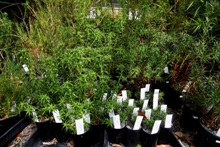
The prices shown are for plants in tubestock - 50 mm forestry tubes or 75 mm round pots. Larger sizes are available for many species.
| Species Name | Common Name | Description | Price |
|---|---|---|---|
| Hakea epiglottis | Beaked Hakea | Endemic to Tasmania, this hardy shrub will grow to 3m x 2m. Creamy white flowers in spring. Images Distribution Map | |
| Hakea epiglottis | Apsley Yellow | This form of the endemic Beaked Hakea is from the banks of the Apsley River. It will grow to 2.5m and displays yellow flowers in spring. Suitable for most conditions. | |
| Hakea lissosperma | Needle Bush | A fast growing, large bushy shrub or small tree to 6m x 3m. An excellent screening plant. Prefers a slightly moist site but adapts to drier conditions. White flowers in spring. Images Distribution Map | |
| Hakea megadenia | Autumn Hakea | Endemic to S.E. Tasmania, and growing to 3m x 2m, this hardy shrub displays creamy white flowers in autumn. Suitable for most conditions. Images Distribution Map | |
| Hakea microcarpa | Small Fruit Hakea Hakea | A spiky shrub to 2 m adapted to survival in extreme cold. Small white flowers. Images Distribution Map | |
| Hakea nodosa | Yellow Hakea | Soft-foliaged coastal shrub to 2-3 m in well-drained soils. Scented yellow flowers in winter. Images Distribution Map | |
| Hakea sericea | Bushy Needlewood | A hardy, dense prickly shrub to 3 m or more. Provides good refuge for small birds. White or pinkish flowers in winter-spring. Images Distribution Map (This species is now called Hakea decurrens subsp. physocarpa.) | |
| Hakea teretifolia | Dagger Hakea | A spiky hakea with distinctive seed pods. Suitable for well-drained sites. Images Distribution Map | |
| Hakea ulicina | Furze Needlebush | A particularly dense, spiky bush (don't be fooled by the juvenile foliage)! White flowers. In Tasmania only grows on Flinders Island. Images Distribution Map | |
| Helichrysum pumilum var pumilum | Tiny Alpine Daisy | Slow growing plant with a small clump of leaves and red buds opening to white flowers to 5 cm. Cute! Images Distribution Map | |
| Helichrysum scorpioides | See Coronidium scorpioides | ||
| Herpolirion novae-zelandiae | Sky Lily | A prostrate, suckering alpine lily. A mat of short grass-like foliage features ethereal sky blue, six-petalled flowers, nestled amongst the leaves in summer. Moist sites or pot. Images Distribution Map | |
| Hibbertia appressa | Scrambling Guinea Flower | A bushy, shrubby scrambler to 2m. Requires fixing to a support, or will grow up through other shrubs. Massed bright yellow flowers in spring. Likes a moist spot. Very similar to Hibbertia empetrifolia. Images Distribution Map. | |
| Hibbertia procumbens | Spreading Guinea Flower | A prostrate plant spreading to 1 m with attractive yellow flowers in latge spring and early summer. Requires a well-drained position, preferably with a dash of shade. Images Distribution Map | |
| Hibbertia prostrata | Prostrate Guinea Flower | A fine-foliaged plant with spreading stems to 30 cm. Yellow flowers in spring. Best in a well-drained site. Images Distribution Map | |
| Hibbertia riparia | Erect Guinea Flower | A small shrub to 50cm, with erect stems decorated nicely in late spring with a profusion of clear yellow flowers. Well drained soils. Can be hard pruned. Images Distribution Map | |
| Hibbertia serpyllifolia | Fine Leaf Guinea Flower | A fine leaved, soft foliaged plant to 15cm high by 40cm wide. Masses of clear yellow flowers in spring. Well drained sites or as a pot plant. Images Distribution Map | |
| Huon Pine | See Lagarostrobos franklinii | ||
| Hydrocotyle sibthorpioides | Hairy Pennywort | A suckering, soft-foliaged groundcover, forming a pale green mat, in a moist, cool position or pot. Images Distribution Map G5-8, P6-8. |